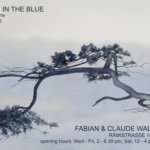
Blue tapestry
We are delighted to invite you to a private viewing of a collaborative event between Angela Lyn, Dominik Rinnhofer and Ideal Spaces. The event takes as its impetus the intertwining of the analogue and the digital in a traditional fine art space.
U Gehmann:
When looking at our common artwork, the seemingly smoothness of the analogue and the digital united with each other must not be deceived: it isn’t smooth at all, just as little as our present situation is. What gets combined here, in the artwork, is symbolic in many respects.
If we take the nature of the symbol derived from its original Greek meaning, a symbol is more than just a representation of something as our recent modern understanding has it: that reality is only to be experienced in an indirect, mediated way via its various representations. It is a conception of the real and of the world as such that has refrained from the ability to immediately understand, to incorporate emotions, spirituality, the unity of mind and soul into the act of seeing; instead, we have been trained to look at the world in that mediated way guided (in the final) by rational principles, like a cold Cartesian gaze. Therefore, the world can speak to us only in a mediated way, via its diverse “representations”.
A symbol in its original sense meant a full representative of something, e.g. of the situation we are in today, and not just a representation. In that way our artwork has to be envisaged: it shows our recent situation as its representative, directly and intuitively stands for it.
Our artwork is symbolic. On its surface, it shows a seemingly harmony: between an “old”, natural world now called an “analogue” world. And a new world completely rationalized, symbolized by its technological apex and epitome, the so-called digitalization; making up a new world, the “digital.” Alongside with the connotations aligned with this dichotomy, connotations adopting the form of an unthought known, a common body of cultural knowledge. Namely that the old world is a one we may long for in a utopian drive, but which has gone and belongs to an outdated past; versus a new world of bright technological possibilities which according our Christian cultural heritage aim to overcome the existing, to leave the boundaries and confinements of space, time, and matter for a new era of human omnipotence.
Another symbolic dimension is the contrast: below a harmoniously looking surface, doom is unfolding. On the surface, we live in an era of unprecedented wealth, with the new digital means at hand allowing us to consume (in real time, a new dimension of consume) even the whole of the world as private applications, to treat the world as if it were an app. Such a world as app, ready to be consumed, appears to us in fragments, as an agglomeration of different individual jigsaw puzzles – but not as a whole, not as a world as it is. Into The Blue is one facet of this style of living: we behave as if such a World as App would last forever. We are living in the blue, in this respect.
On the other hand, we are going into the blue, as if to sail on a large and unknown ocean. As in an ocean, dangers loom below its surface. We all heard about climate changes, disruption of the natural and social ecology threatening our very oikos, our planet as our home to live. In fact, the base of our existence is threatened. Such a future may be located in the blue, but unfortunately, it has a destined trajectory. It becomes a utopia, an ou-topos in the literal sense of utopia: a place where humans cannot live. Not only as regards climate change and its aligned ecological crises. According to United Nations-reports, in the very next future (until an estimated 2050), 60% of the world population will live in cities, and two thirds of them in slums. Imagine what this means not just for civilization, but for human culture as such.
If we combine such a scenario with an other one imminent also as a reality today, climate change, growing world population and all accompanying ecological and economic disasters, we already now live in the blue.
